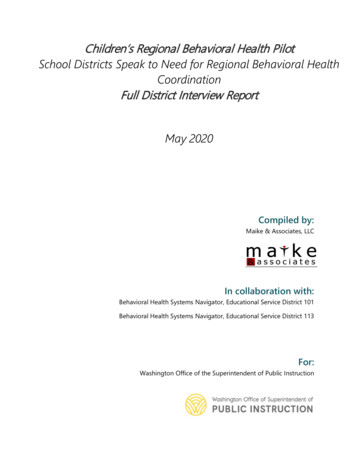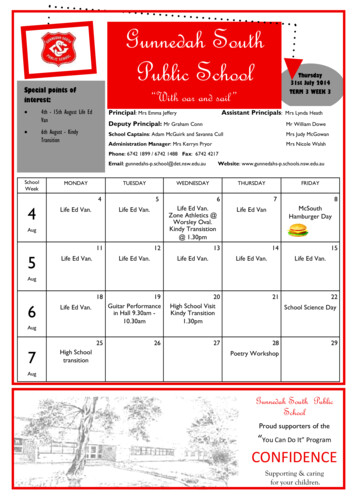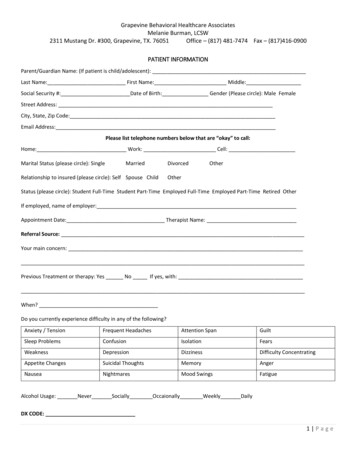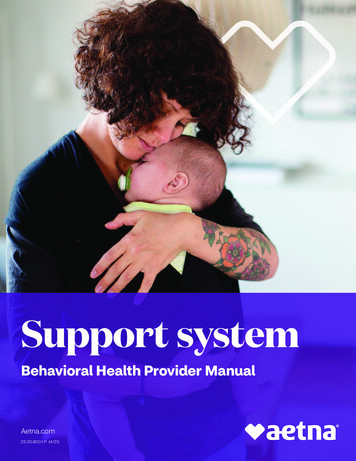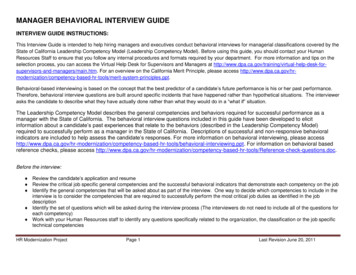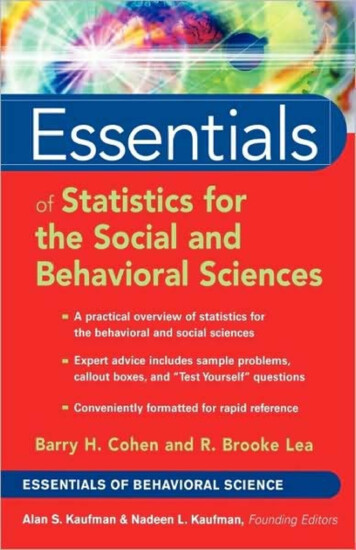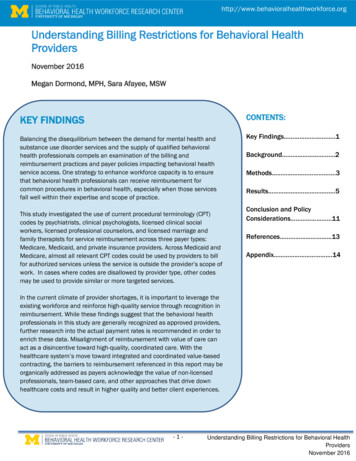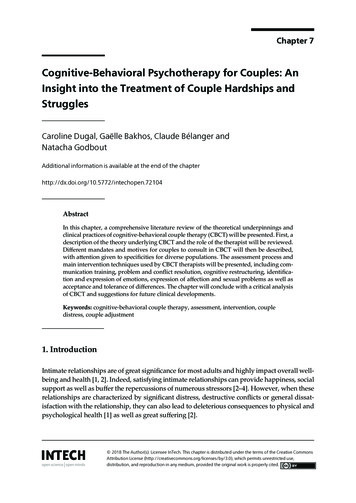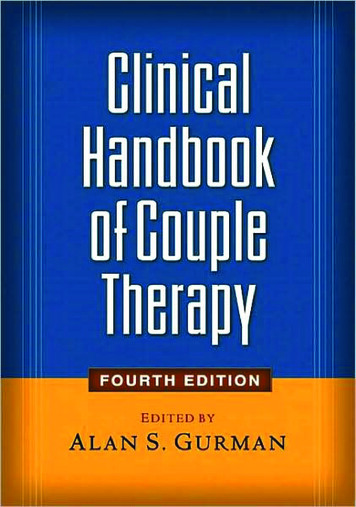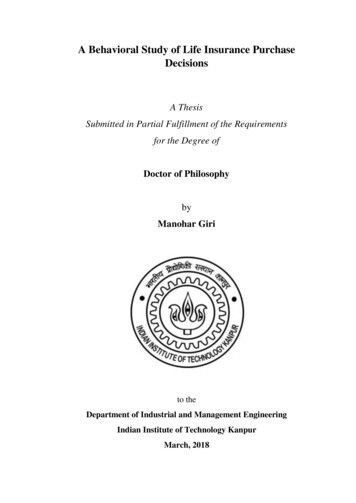
Transcription
A Behavioral Study of Life Insurance PurchaseDecisionsA ThesisSubmitted in Partial Fulfillment of the Requirementsfor the Degree ofDoctor of PhilosophybyManohar Girito theDepartment of Industrial and Management EngineeringIndian Institute of Technology KanpurMarch, 2018
Statement of Thesis Preparation1. Thesis title: A Behavioral Study of Life Insurance Purchase Decisions2. Degree for which the thesis is submitted: Doctor of Philosophy3 Thesis Guide was referred to for preparing the thesis.4. Specifications regarding thesis format have been closely followed.5. The contents of the thesis have been organized based on the guidelines.6. The thesis has been prepared without resorting to plagiarism.7. All sources used have been cited appropriately.8 The thesis has not been submitted elsewhere for a degree.Manohar GiriRoll No.: 13114062Industrial and Management Engineering DepartmentIIT Kanpur
CERTIFICATEIt is certified that the work contained in the thesis titled “A Behavioral Study of LifeInsurance Purchase Decisions” by “Manohar Giri” has been carried out under mysupervision and that this work has not been submitted elsewhere for a degree*March, 2018Dr. Devlina ChatterjeeAssistant ProfessorDepartment of Industrial and Management EngineeringIndian Institute of Technology, Kanpur
-------------------------------------Name of StudentManohar GiriRoll no13114062Degree for which submittedDoctor of PhilosophyDepartmentIndustrial and Management EngineeringThesis TitleA Behavioral Study of Life insurancePurchase DecisionsName of Thesis SupervisorDr. Devlina ChatterjeeMonth and year of thesis submissionMarch, ---------------------------------The insurance market in India is highly concentrated with the Life Insurance Corporation ofIndia (LIC) having more than 70% of the market share. High levels of financial illiteracy leadto significant information asymmetry in the market. Many households lack access to the formalfinancial sector and do not have bank accounts. In this context, insurance agents are often theonly source of information. Insurance is often perceived as an alternative investment optioneven though the returns from this mode of investing may be less than optimal. A 2014 studyestimated that the loss to the consumer from lapsed insurance policies between the years of2004 and 2011 was about 28 billion.Consumer choice in the insurance sector has been studied extensively in the context ofdeveloped economies. Many of these studies assume that consumers make rational choicesaiming to maximize their utility under wealth and information constraints. Risk minimization,bequest and investment motives often drive the demand for life insurance. Several authors havenoted examples of insurance purchase behavior that are inconsistent with models of rationalchoice. Behavioral models have been proposed to explain anomalies in consumer behavior thatare not explained by the expected utility models.The aim of the current study is to understand the behavioral aspects of insurance purchasedecisions. This thesis studies four different aspects of the insurance market in India. First, wetry to develop an econometric model for insurance demand at household level. Second, we
iiinvestigate how individual beliefs, attitudes and social norms affect insurance purchasedecisions. Third, we look at why individuals choose different types of policies, whether it isterm, endowment or multiple policies, and whether this choice meets their individual needs oris led by social pressure. Finally, we look at the reasons that lead to lapsation of policies andwhether this is related to the original motive for insurance purchase. The results from both thethird and final chapters of this thesis are indicative of possible mis-selling of insurance in India,where individuals may purchase insurance due to social pressures and aggressive selling tacticsby insurance agents.In the first part of the thesis, we study the determinants of household demand for life insurancein India. A unique short panel dataset comprising of 34,855 households surveyed in the IndianHuman Development Survey (IHDS) in 2004-05 and 2011-12 was used for this purpose. Socioeconomic status, education level of the household head, asset ownership, family composition(households headed by women, family size and child birth) and initiation of a relationship witha bank had statistically significant effects on purchase of life insurance. The main differenceamong rural and urban households was that financial inclusion (in terms of loans availed andrelationship with a bank) affected the former but not the latter.In the second part of the thesis, the objective was to understand how consumers arrive at thedecision to purchase life insurance. The theory of planned behavior (TPB) was the theoreticalmodel used. Following this model, we were interested in seeing how beliefs, social norms,attitudes and perceived behavioral control affect the decisions to purchase insurance. Aquestionnaire was developed and primary data was collected from 386 respondents from 20cities and 20 villages of UP, Rajasthan and Uttarakhand and other parts of the country. Astructural equation modeling approach was used. Beliefs about insurance and subjective normswere found to be inextricably linked with each other. These and perceived behavioral controlaffected attitudes towards insurance and attitudes in turn affected purchase behavior.
iiiIn the third part of the thesis, we wanted to understand how individuals made choices in termsof the kind of insurance policy they purchase. From survey of the literature, we concluded thatthere was significant amount of mis-selling of life insurance policies in India. Mis-selling wasnot only in terms of whether a person should buy insurance but also what kind of policy he orshe should purchase. This was the motivation for this part of the study. We wanted tounderstand the reasons for choosing different kinds of policies. We researched differentmotives that individuals had for purchasing insurance including (i) tax saving, (ii) saving forfuture expenses, (iii) bequest for the family in case of untimely death and(iv) social motivessuch as influence of the insurance agent or bank personnel. Tax savings motives were found tobe positively related to the purchase of term policies, while savings and bequest motives werepositively related to the purchase of endowment policies. Social influence was the primarymotive related to the purchase of multiple policies.Finally, we investigated the reasons behind lapsation of policies. Lapsation of policies may bedue to deterioration of financial conditions, or due to the original reason for insurance purchasebecoming irrelevant, or due to the mis-selling of insurance where the policy was purchasedunder social pressure. The question we tried to address was as follows: What were the originalmotives for insurance purchase for those policy holders, whose insurance coverage lapsed.Insurance coverage of individuals who were less financially aware and those who weremotivated because of social reasons were more likely to lapse within a few years, indicatingthat it may not have been needed in the first place.The findings indicate that in India's emerging economy many customers rely on advice fromtheir agents when they decide to purchase an insurance policy. Applying the theory of plannedbehavior, we find that subjective norms have a significant effect on the decision to purchaseinsurance. Social influence is also found to affect choice of policies. This may lead tosuboptimal decisions where customers may buy insurance policies that do not address theirfinancial needs. There is a need for greater education and awareness programs for consumers inthis rapidly growing industry.
ivAcknowledgementsI have had the friendship and support of many people in my doctoral journey at IIT Kanpur. Itake this opportunity to express my gratitude to all of them.First and foremost, I would like to express my sincere gratitude to my thesis supervisor Dr.Devlina Chatterjee for her continued moral support and guidance which led to the completionof the present work. All the interactive sessions I have had with her during this period havebeen inspiring and rewarding for me. It was a great pleasure to work with her as she wasexceptionally cooperative, helpful, modest and caring. This thesis is a small tribute to anexceptional teacher from a student still anxious to learn from her.I wish to thank esteemed faculty members of IME Department for their ever-helpful attitudeand cooperation at various stages during the PhD program. Thanks, are also extended to theoffice staff of the IME Department; they were always warm, cordial, and helpful.I would like to thank to Sanjay Gupta, Tanvi Keswani and Sruthy S. for helping me in datacollection. This work would not have been completed without their help. I would also like tothank all of my friends and research colleagues at IME lab whose unselfish support and loveduring this journey will live in my memory.I wish to thank my entire family for all their love, encouragement, and support in all mypursuits. My special gratitude is due to my mother and brothers who were particularlysupportive and always kept me away from family responsibilities and encouraged me toconcentrate on my studies throughout the long journey of my educational career.I express my sincere thanks to all the subjects who participated in this research with interestand enthusiasm and gave their precious time to my work. Finally, to all those who directly orindirectly supported and inspired me in any respect during my doctoral study and made thisthesis possible.
vTable of ContentsSynopsis . iAcknowledgement. ivTable of Contents . vList of Tables . xiList of Figures . xiiiList of Acronyms. xivChapter 1. Introduction . 11.1Background . 11.2Research Motivation. 21.3Rational and Behavioral Theories in Insurance Economics . 31.4Evolution of the Life Insurance Sector in India . 41.5Research Questions Addressed in this Study . 51.6Outline of the Study. 7Chapter 2. Socioeconomic and Demographic Factors Affecting Changes in Demand forLife Insurance . 82.1Introduction . 82.2Literature Review . 102.3Motivation for Research and Research Questions . 13
vi2.4Research Methodology . 152.4.1Data . 152.4.2Data Preparation for the Analysis. 162.4.3Specification of the Logistic Model . 172.4.4Definition of Dependent Variable. 172.4.5Independent Variables . 192.4.6Model Specification: . 212.4.7ANOVA of Models to Capture Effect Size . 222.5Results and Discussion . 232.5.1Checking data for Multicollinearity: . 262.5.2Acquisition of Life Insurance -Results of the Logistic Regression Models. 262.5.3Results of ANOVA of Nested Models. 302.5.4Discontinuation of Life Insurance -Results of Logistic Regression Models 312.5.5Expenditure on Insurance Premium - Results of Linear Regression Models . 332.6Discussion . 36Chapter 3. Consumer Behavior in Life Insurance: Theory of Planned Behavior . 383.1Introduction . 383.2Theoretical background . 40
vii3.2.1Theory of Reasoned Action (TRA) . 403.2.2Theory of Planned Behavior (TPB). 423.3Literature Review . 433.3.1Rational and Behavioral Theories in Insurance Economics . 433.3.2Behavioral Models of Insurance Purchase . 453.3.3Insurance Purchase - Behavioral and Psychographic Factors . 453.3.4Insurance Purchase - TRA and TPB . 463.4Research Questions . 473.5Methodology . 483.5.1Hypotheses. 483.5.2Data and Sample . 493.5.3Research Instrument . 493.5.4Measurement. 503.6Results. 503.6.1Exploratory Factor Analysis for Beliefs, Attitudes and Subjective Norms . 503.6.2Structural Equation Modeling of the Behavioral Intention Model . 533.6.3Goodness of fit of the SEM model . 573.7Discussion . 58Chapter 4. Factors Affecting Choice of Insurance Policy . 59
viii4.1Introduction . 594.2Literature Review . 604.2.1Insurance is a Complex Decision . 604.2.2Collectivist Cultures and Influence of Insurance Agents . 614.2.3Motives for Buying Insurance . 624.3Research Gaps and Motivation for the Study . 634.4Research Methodology . 664.5Results. 684.5.1Demographic Factors as Determinants of Policy Choice . 724.5.2Reasons for Purchasing Life Insurance Policies . 744.5.3Motives for Purchasing Term Policies . 764.5.4Motives for Purchasing Endowment Policies . 774.5.5Motives for Purchasing Multiple Policies . 784.6Discussion . 79Chapter 5. Factors Affecting Lapsation of Policies . 815.1Introduction . 815.2Literature Review . 835.2.1Causes of Policy Lapsation . 83
ix5.2.2Empirical Research on Microeconomic Factors affecting Policy Lapsation 855.2.3Mis-selling and Lapsation of Policies – Evidence from India . 855.3Motivation for the Study and Research Questions . 865.4Research Methodology . 885.5Results. 905.5.1Duration of Policy Lapse: . 925.5.2Reasons given for Policy Lapsation: . 935.5.3Demographic Determinants of Policy Lapsation . 945.5.4Purchase Motives and Policy Lapsation . 965.6Discussion . 97Chapter 6. Conclusion . 99Bibliography. 104Appendix A(I)- Classical Theories on Life Insurance Demand. 110Appendix A(II)- Departure from Classical Models of Life Insurance Demand . 112Appendix A(III)- Socioeconomic and Psychographic Predictors of Life Insurance Demand. 116Appendix A(IV)- Theory of reasoned action(TRA) and Theory of Planned Behavior(TPB). 121Appendix A(V)- Life Insurance Studies in India . 124Appendix A(VI)- Life Insurance policy Lapse/ Mis-selling . 128
xAppendix A(VII)- Financial literacy/ Financial Knowledge . 132Appendix B - New Consumer Classification System . 135Appendix C. 137Appendix D. 143Appendix E . 147Appendix F . 149Appendix G- Insurance Questionnaire . 151Appendix H- Map of the Cities and Villages from which Data was Collected. 155Appendix I- Reported Reasons for Life Insurance Policy Lapse . 156Appendix J- List of Variables available in Indian Household Development Survey (IHDS). 157Appendix K- R codes for analyzing Life Insurance acquisition and dropping decisionsusing IHDS 2005 and 2011 datasets . 159Appendix L- R codes for analyzing Premium expenditure using IHDS 2005 and 2011datasets . 179Appendix M- R Codes for Policy Choice and Policy Lapse Models . 181
xiList of TablesTable 2.1 Characteristics of Households Included in the Sample . 18Table 2.2 Number of Rural and Urban Households with Life Insurance Percentages . 23Table 2.3 Comparison of Insured and Uninsured Household Characteristics . 26Table 2.4 VIF for Different Independent Variables . 26Table 2.5 Results of Logistic Regression Models for Acquisition of Life Insurance . 29Table 2.6 ANOVA Results of Models for Buying of Life Insurance . 30Table 2.7 Results of Logistic Regression Models for Discontinuation of Life Insurance . 32Table 2.8 ANOVA Results of Models for Discontinuation of Life Insurance . 33Table 2.9 Results of Regression Models for Expenditure on Insurance in 2011 . 34Table 3.1 Exploratory Factor Analysis of Behavioral Component of Insurance Survey . 52Table 3.2 Reliability statistics to measure the internal consistency of model constructs . 53Table 3.3 Regression Estimates for Life Insurance Purchase . 55Table 3.4 Direct, Indirect and Total Effects . 56Table 3.5 Model Fit Summary . 57Table 4.1 Ownership Details of Different Life Insurance Policies . 68Table 4.2 Demography-wise Distribution of Different Kinds of Life Insurance Policies . 71Table 4.3Demographic Factors Affecting Choice of Policy – Results of Logistic RegressionModels. 73Table 4.4 Results of the Factor Analysis on Reasons for Taking Life Insurance . 75Table 4.5 Effect of Investment Motives vs. Social Motives on Choice of Life Insurance . 76Table 4.6 Term Life Policy Purchase Motives - Logistic Regression Results . 77Table 4.7 Endowment Policy Purchase Motives - Logistic Regression Results . 78Table 4.8 Multiple Policy Purchase Motives - Logistic Regression Results . 79Table 5.1 Percentage of Lapsed Insurance Policies among Different DemographicSegments . 91
xiiTable 5.2. Types of Life Insurance Owned Among those that have Reported Policy Lapse. 92Table 5.3. Demographic and Socioeconomic Determinants of Lapse -Logistic Regression. 95Table 5.4 Effect of Purchase Motives on Lapse of Insurance – Logistic Regression Models. 96Table B.1 SEC System . 135Table D.1Step wise Backward Logistic Regression Models. 143Table D.2 Step wise Backward Logistic Regression Models. 144Table D.3 Step wise Backward Logistic Regression Models. 145Table D.4 Step wise Backward Logistic Regression Models. 146Table E.1 Step wise Backward (Nested) Logistic Regression Models for InsuranceAcquisition. 147Table E.2 Step wise Backward (Nested) Logistic Regression Models for InsuranceAcquisition. 148Table F.1 Step wise Backward (Nested) Logistic Regression Models for InsuranceDiscontinuation . 149Table F.2 Step wise Backward (Nested) Logistic Regression Models for InsuranceDiscontinuation . 150Table I.1Reasons for Life Insurance Policy Lapse . 156
xiiiList of FiguresFigure 2.1 Percentage of Insured Households in 2005 and 2011 - Rural Households . 24Figure 2.2 Percentage of Insured Households in 2005 and 2011 -Urban Households . 24Figure 3.1 Pictorial Depiction of the Theory of Planned Behavior (Source: Ajzen, 1985) 43Figure 3.2 Structural Equation Model for Life Insurance Purchase Behavior . 54Figure 4.1 Distribution of Life Insure Policy Holders across different Insurance Providers. 69Figure 5.1 Duration of Policy Lapse . 93Figure 5.2 Reason for Insurance Lapsation . 94Figure C.1. Age Comparison between Insured and Uninsured. 137Figure C.2. Educational difference between Insured and Uninsured . 138Figure C.3. Income Comparison between Insured and Uninsured. 139Figure C.4. Difference in Consumption Expenditure of Insured and Uninsured. 140Figure C.5. Family size Comparison between Insured and Uninsured . 141Figure C.6. Difference in number of Children between Insured and Uninsured . 142Figure H.1 Map of the Areas of Study . 155
xivList of AcronymsAGFIAdjusted Goodness of Fit IndexAICAkaike Information CriterionANOVAAnalysis of VarianceBEBehavioral ExpectationBIBehavioral IntentionBPLBelow Poverty LineCFIComparative Fit IndexEFHEmergency Fund HypothesisGDPGross Domestic ProductGFIGoodness of Fit IndexGNDIGross National Disposable IncomeHDFCHousing Development Finance CorporationICICIIndustrial Credit and Investment Corporation of IndiaIFIIncremental Fit IndexIFPSIndia Financial Protection IndexIHDSIndian Human Development SurveyIRDAIInsurance Regulatory and Development Authority of IndiaIRHInterest Rate HypothesisLICLife Insurance Corporation of IndiaMLEMaximum Likelihood EstimationNCAERNational Council of Applied Economic ResearchNCCSNew Socioeconomic Classification SystemNLSYNational Longitudinal Survey of YouthNSHIENational Survey of Household Income and ExpenditurePBCPerceived Behavioral ControlPGFIParsimony Goodness of Fit IndexPMJJBYThe
3 Thesis Guide was referred to for preparing the thesis. 4. Specifications regarding thesis format have been closely followed. 5. The contents of the thesis have been organized based on the guidelines. 6. The thesis has been prepared without resorting to plagiarism. 7. All sources used have been cited appropriately.

